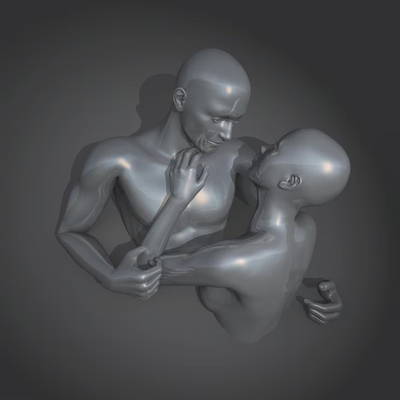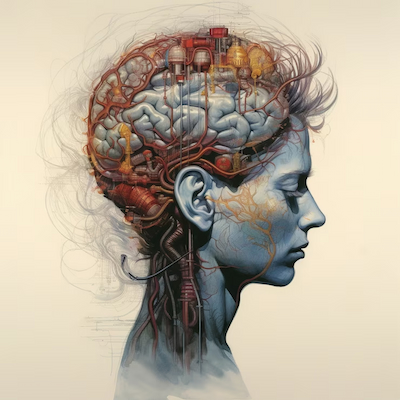
Anatomical drawing is an artistic practice that involves the detailed representation of the human body, taking into account both its internal and external structure. This technique is not only a form of art but also a way to study human anatomy, allowing artists and students to better understand muscles, bones, and the dynamics of movement. The representation of the human body has played a fundamental role throughout art history—from cave paintings to the masterpieces of the Renaissance, where the pursuit of perfection in depicting the human form reached its peak.
The importance of anatomical drawing goes beyond aesthetics; it serves as a valuable educational tool for artists, doctors, and scientists alike. Understanding human anatomy enables artists to create more realistic and expressive works, while healthcare professionals can apply this knowledge to enhance their practices. In this way, anatomical drawing becomes a bridge between art and science, enriching both fields.
How Anatomical Drawing Techniques Work in Representing the Human Body
Anatomical drawing techniques are based on a deep understanding of human anatomy. Artists dedicated to this practice often begin by studying the skeletal structure, which serves as the foundation upon which muscles and skin are built. Knowledge of bones, joints, and their relationships is essential for creating drawings that are not only visually appealing but also anatomically accurate. From this base, the artist can add layers of muscles, which are crucial for conveying motion and emotion in their work.
Moreover, direct observation of the human body—whether through live models or cadavers in anatomy classes—is critical in the learning process. Artists are encouraged to study proportions, movement lines, and facial expressions, all of which are fundamental to realistic representation. This observation practice is not limited to drawing; it can also include sculpture and other three-dimensional forms, where understanding shape and volume is equally important.
Shading techniques and the use of various materials also play a significant role in anatomical drawing. The choice of pencil, charcoal, ink, or even digital tools can affect how light and shadow are rendered, influencing the perception of depth and texture. Artists learn to manipulate these elements to create a sense of realism and three-dimensionality, making their representations of the human body even more convincing.
Finally, the use of photographic references and historical artworks is a common practice among artists studying anatomical drawing. By analyzing works from masters such as Michelangelo and Leonardo da Vinci, contemporary artists can learn about the techniques these great figures used to capture the essence of the human body. This exchange of knowledge across centuries makes the study of anatomical drawing a rich and constantly evolving discipline.

Advantages of Studying Anatomical Drawing and the Representation of the Human Body in Art
Studying anatomical drawing offers several significant advantages for artists and art students. First, understanding human anatomy allows artists to create more realistic and convincing works. By mastering body proportions and structure, they are able to represent not only form, but also emotion and movement—resulting in artwork that resonates more deeply with the viewer.
Another advantage is the improvement in drawing technique. Studying anatomy forces artists to focus on details often overlooked in more stylized representations. This leads to an overall enhancement of drawing skills, as artists learn to observe and accurately reproduce the nuances of the human form. This attention to detail can also be applied to other areas of art, enriching artistic practice as a whole.
Additionally, anatomical knowledge is extremely valuable for artists working in related fields such as medical illustration or character design for animation and games. In these fields, anatomical precision is crucial, and artists with a strong foundation in anatomical drawing have a significant competitive edge. They can create representations that are not only visually appealing but also functionally accurate.
Lastly, studying anatomical drawing fosters a deeper appreciation for art and art history. By understanding the techniques and challenges faced by past artists, art students can develop greater admiration for the work of the masters and the evolution of human body representation through the centuries. This connection to history enriches the artistic experience and inspires new generations to carry on the tradition.
How to Apply Anatomical Drawing and the Representation of the Human Body in Art
To apply anatomical drawing and the representation of the human body in art, it is essential to follow several key steps. First, it is important to develop a solid foundation in anatomical knowledge. This can be done through studying books, taking courses, and attending hands-on anatomy classes, where students learn about the skeletal structure, muscles, and how they interact. This theoretical base is crucial for any artist who wants to accurately depict the human form.
In addition, consistent practice is vital. Artists should devote time to drawing live models in various poses and from different angles. This practice not only improves observational skills but also helps internalize the dynamics of the moving human body. Repetition and experimentation are fundamental to developing a personal style that effectively incorporates anatomy.
Another way to apply anatomical drawing is through the analysis of classical and contemporary artworks. Studying how other artists have approached the representation of the human body can provide valuable insights into techniques and styles that can be adapted and incorporated into one’s own work. This critical analysis is an important aspect of artistic growth, allowing students to learn from the masters.
Finally, incorporating new technologies such as 3D modeling software and digital drawing tools can expand the possibilities for representing the human body. These tools allow artists to experiment with form and structure in ways not possible through traditional methods alone. Combining classical and modern techniques can result in innovative works that reflect the complexity and beauty of the human figure.
Study Anatomy: Dedicate time to learning the skeletal and muscular structure of the human body.
Practice with Live Models: Draw frequently from live models to capture movement dynamics.
Analyze Works of Art: Study how other artists have represented the human form in their work.
Experiment with Different Styles: Try various techniques and styles to find an approach that resonates with you.
Use Digital Tools: Explore 3D modeling software and digital drawing platforms to expand your skills.
Join Workshops: Enroll in anatomical drawing workshops and courses to sharpen your abilities.
These steps are essential for anyone who wants to apply anatomical drawing and human body representation in art. Ongoing practice and a commitment to learning are key to artistic development and the creation of impactful works.

Did You Enjoy Learning About Anatomical Drawing and the Representation of the Human Body in Art?
Anatomical drawing and the representation of the human body in art are fascinating subjects that connect aesthetics with science. By exploring these areas, you not only improve your artistic skills but also gain a deeper appreciation for the complexity of the human form. It is a journey well worth exploring.
If you found this topic interesting, continue your research and practice. There is a world of knowledge and technique waiting for you, and every new discovery can enrich your artistic experience in surprising ways. Anatomical drawing is a gateway into a creative and educational universe with endless possibilities.
Frequently Asked Questions
What is anatomical drawing?
Anatomical drawing is the detailed representation of the human body. It shows muscles, bones, and organs. It’s very important for artists and medical students.
How does anatomical drawing help in art?
It helps you understand how the human body moves. This improves your artistic skills. Your works become more realistic and impressive.
What are the main elements of anatomical drawing?
The main elements include bones, muscles, and proportions. You should learn about each part. It will help you draw better.
Where can I learn about anatomical drawing?
You can find books, online classes, and tutorials. Choose what works best for you. Practice regularly to improve your skills.
Why is the representation of the human body important in art?
It shows the beauty and complexity of the human body. It expresses emotions, movements, and stories. It helps you connect with the viewer.

